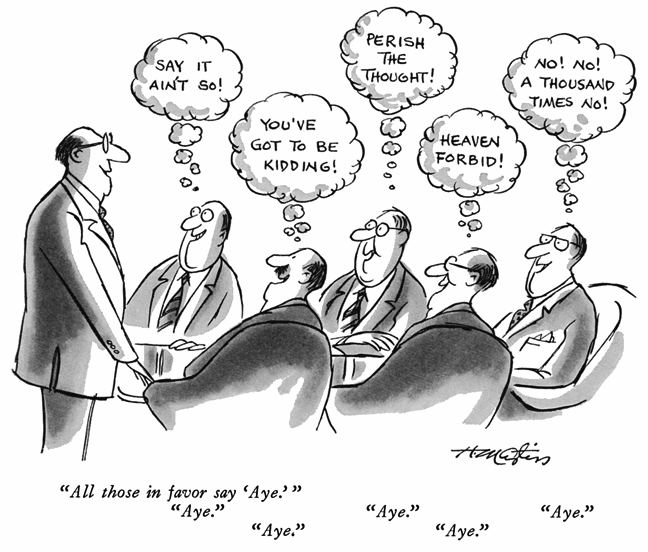
It’s probably one of the most crucial life skills anybody can ever have! Much has been written about this topic. An impassioned talk is all it takes to get the world moving you say! Unless you are Martin Luther King how far has that taken you. Let’s take TED Talks for example, the epitome of knowledge and passion. You have probably been WOWed on more than one occasion. You were so moved you even tweeted the link! As Malcolm Gladwell once pointed out “Why the revolution won’t be tweeted“. He made a point. Influencing change requires more than an impassioned plea, and it certainly requires more than just a tweet! When you are sharing an idea that you have crafted and feel passionately about, you are up to your ears about the information related to your idea. You are likely to have spent hours and days if not weeks to craft your final thoughts. However coming up with a vision for change and driving it in a way that is internalized across an organization are two different things! Harvard professor John Kotter concluded that change agents under communicate their vision by a factor of at least ten. In a three month period employees on average are exposed to 2.3 million words and numbers. During that same period a vision for change maybe communicated in about 13,400 words, probably through a 30-minute speech or an hour-long meeting! With 99% of the communication unrelated to the vision how can change be even understood let alone internalized! If this blog post were written by Simon Senek he would ask you to “Start with Why!” But since this post is not by him I’m going to talk about “Why not?” “Who?” and “How?”. Of course ‘why’ would always matter! But unfortunately in everyday life not every plea for action is about making the world a better place! No lives would be lost if action is not taken. There are times when action needs to be taken to improve business performance, when investors need to fund your business , when a CMO needs to approve your marketing plan, when employees need to improve performance to advance a corporate goal! How can your audiences be influenced in these circumstances to take action? What if you don’t always need to bring your “A” game to the table?
Problem with Perfection
Nobody likes being sold. There is no such thing as a perfect pitch. We have an inherent tendency to poke holes in the best of ideas. This tendency to criticize is so deep rooted that it even impacts our perceptions of intelligence. In a fascinating experiment a set of literary reviews were crafted to create two identical versions with the only difference being the adjectives – one version was all positive and the other was all negative. After reading the reviews people were asked to gauge the intelligence and literary expertise of the reviewers. Can you imagine what the results were? People rated the critical reviewer to be 14% more intelligent than the complimentary reviewer and rated the critical reviewer to have 16% greater literary expertise than the other. What does this mean when it comes to influencing people? Instead of trying to convince people outright on the greatness of your proposition state the reasons why your idea might fail. By doing so you disarm your audience and gain their trust. Why? Because you are no longer selling. By presenting the drawbacks your audience becomes your ally. Instead of looking for flaws they look at the drawbacks as problems to solve and thus gain ownership of the idea. This approach addresses the “not-invented-here” bias that makes it difficult for us to accept another’s idea unless somehow we are made to be part of the ideation process. Finally the most surprising reason why stating drawbacks can positively influence your audience is another bias that affects the way we think about things. In an experiment two groups of people were asked to list the things that make them happy. One group was asked to list three things that make them happy. The other group was asked to list twelve things that make them happy! Which group reported more happiness? The ease of recall that the group with three things to list experienced enhanced their self-perception of happiness. The other group struggled to list twelve things and believed that they are not happy simply because of the effort they had to apply to come up with their list. By presenting the flaws to a proposition you bring your audience’s guard down, take the effort away from thinking about the negatives and thus redirect their thinking to the positives. The end result? Your idea has a better chance of being accepted.
Who are you?
Influence has a lot to do with who you are. That is obvious. Who you are has to do with your status and power. Power comes from your position. You maybe in a position of power probably as a CEO or a Team Leader. Therefore it’s naturally easier to exercise influence at such a position. But what if you are not in a position of power. What can one do then? This is where status comes in. Unlike power, status is not taken, it is earned. With status one can exercise power and make a difference. But earning status is hard work. Earning status means earning the respect and admiration of one’s peers, subordinates and superiors. It’s easier said then done! Here I would like to illustrate the story of Carmen Medina. How she revolutionized information sharing at the CIA and took it from the analog to the digital world! At an organization like the CIA information is everything. It is sacred. It is power. It is old school. Why? To ensure information security everything at the CIA was always shared in printed form so that it could be controlled and delivered to only the people who need to see it. However the world was changing. The internet was transforming the way information was shared. Carmen saw the potential of digitizing information sharing, making it real time and interagency instead of waiting for reports to be physically delivered. But the culture at the CIA didn’t allow her to make this change. She neither had the status nor any power. On top of that she was a woman! Yes that is still a very real problem. Several studies have confirmed that strong gender-role stereotypes still prevail across cultures even today. The stereotype for women it seems is to be communal and for men to be assertive. If they challenge that they are going to face resistance. In one experiment at a major international bank men received positive evaluations for speaking up while women who did so suffered. Men who talked more than their peers were rewarded while women who did the same were devalued by both men and women! How did Carmen overcome this? She didn’t. At least not the first time. After quitting the CIA she tried to find work elsewhere, but eventually came back and took on a low-level staff position for about three years, before working her way back up. In less than a decade she not only transformed the way information was shared at the CIA by creating an internal wiki platform for intelligence agencies known as Intellipedia but earned the “Service to America Homeland Security Medal” for her contribution. How?
Revolt from Within
Carmen did things differently in her second coming. Instead of rocking the boat from the word go like she did previously she did something she had never done before. She followed the status quo. She took a role in information security and worked her way to the top. She earned the respect and admiration of everyone around her by doing whatever that needed to be done diligently to keep knowledge safe. As the famous filmmaker Francis Ford Coppola once said, “The way to come to power is not always to merely challenge the Establishment, but first make a place in it and then challenge and double-cross the Establishment.” This is an idea you don’t often hear when it comes to driving influence. Even rapid revolutions fail to bring about deep rooted change. Permanent changes can only happen from within. For that to occur one has to be fully part of the system, earn the trust and respect of one’s peers and then work from the inside out. By doing so Carmen Medina eventually got promoted to the executive level and now gained power as well. Now she was in a position to drive change. But she still didn’t just throw everyone off her boat. She found allies and started seeding the idea from the bottom. Coming back to the point I made in the beginning. It’s hard for people to accept new ideas unless they are involved in the process and made to become familiar with it. This is hardest to do when a new idea needs to be sold in let’s say a creative pitch. I have been through this one too many times. The challenge of winning in a competitive pitch is overwhelming. How can one involve an audience and make the unfamiliar familiar to them? If it’s too familiar it’s not fresh. If it’s too fresh it may not be familiar and therefore harder to sell. This is the paradox of creative pitches! A topic indeed for another blog post. Luckily for Carmen she used her allies to a create a dialogue about the change she wanted to bring about. She started a blog on the agency intranet to introduce the concept to everyone. She would regularly share her views on information transparency and secure online sharing. Over time the leadership at the CIA warmed up to her idea. She channeled some resources to develop Intellipedia and slowly introduced it as the go to platform for intelligence sharing.
This is the art of influence. It’s not about crafting the perfect pitch of just the positives but an open communication on both the good and the bad. It’s not about exercising authority to have things done your way but earning the respect and admiration first before influencing behavior. It’s not about starting a revolution but following the status quo first, making one’s place before driving a permanent change. Of course for a topic like influence there is much more that can be said. Feel free to share your comments in the section below.
This blog post has been inspired by Adam Grant’s book “Originals”. A riveting read. Highly recommended to anyone looking for inspiration.
